Mechanical Response and Health Monitoring of Deep Excavations Under Extreme Rainfall
Abstract
1. Introduction
2. Engineering Overview
2.1. Engineering Background
2.2. Geological and Hydrogeological Conditions
3. Field Monitoring
3.1. Slope Crest and Surface Settlement
3.2. Support Monitoring System
3.2.1. Monitoring of Retaining Piles
3.2.2. Monitoring of Supports
3.3. Groundwater Level Monitoring
4. Hydro-Mechanical Coupled 3D Numerical Model
4.1. Model Description
4.2. Hydro-Mechanical Coupling Method
- The governing equation for the saturated–unsaturated groundwater flow can be formulated as follows:
- 2.
- For the specific storage , the compressibility of soil particles can be neglected for simplification, yielding:
- 3.
- The hydraulic boundary conditions are defined as follows:
4.3. Support Beam Elements
4.4. Soil Parameters and Constitutive Models
4.5. Model Assumptions and Limitations
- Isotropic Soil Behavior: The soil is assumed to exhibit isotropic deformation under stress. While this assumption may overestimate the overall soil stiffness, it is considered a reasonable and common simplification for this study, which focuses on global vertical settlement rather than localized, detailed deformations.
- Neglect of Time-Dependent Consolidation Effects: The model employs the Mohr-Coulomb elastoplastic constitutive model and does not account for time-dependent behaviors such as creep and consolidation. Consequently, the predicted deformations are instantaneous. This simplification primarily affects the accuracy of long-term deformation predictions. Given that this research concentrates on the short-term excavation response under extreme rainfall, where time-dependent effects are not the controlling factor, this simplification is deemed acceptable.
- Quasi-Static Groundwater Conditions: The groundwater level is assumed to rise steadily with each rainfall time step, and the pore-water pressure distribution is simplified as steady-state. This approach may underestimate the potential instability associated with infiltration in the unsaturated zone and the redistribution of pore-water pressure. However, as the model assumes saturated soil conditions, the methodology adopted is applicable and effective for assessing the controlling influence of the overall groundwater rise on the global stability of the slope.
4.6. Numerical Simulation Setup
4.6.1. Layered Excavation Working Condition Setup Steps
4.6.2. Groundwater Level Rise Setup Steps
5. Results and Analyses
5.1. Excavation-Induced Response During Layered Construction
5.1.1. Ground Surface Uplift–Subsidence Transition
5.1.2. Excavation Surface Deformation Pattern
5.1.3. Retaining Structure Deformation Behavior
5.1.4. Strut Force Variation and Quantification
5.2. Excavation Behavior and Failure Prediction Under Extreme Rainfall
5.2.1. Ground Surface Uplift–Subsidence Transition
5.2.2. Excavation Surface Deformation Pattern
5.2.3. Retaining Structure Deformation Behavior
5.2.4. Strut Force Variation and Redundancy
6. Discussion
6.1. Excavation Settlement
6.2. Impact of Rainfall on Supporting Structures
6.3. Mechanisms of Rainfall-Induced Excavation Response
6.4. Engineering Application
7. Conclusions
- (1)
- This study quantitatively evaluates foundation pit deformation. During staged excavation, the ground surface at the slope crest exhibits an uplift near the excavation and settlement farther away, with a critical transition occurring within the range of Xt/H = 0.4~0.6. The findings also indicate that after excavation, the maximum uplift at the pit surface is approximately 0.1%H. When the groundwater level rises by 3 m (15%H), the maximum settlement at the slope crest reaches 0.2%H, while the maximum settlement at the pit surface approaches 0.15%H.
- (2)
- During excavation, the maximum deflection of the retaining piles δhm is approximately 0.14% of He, with the greatest lateral deformation occurring in the lower portion of the retaining pile. When the groundwater level rises, support axial forces increase by up to 16% and the maximum lateral displacement δhm of the retaining piles increases by 90%, with the largest displacement observed near the excavation bottom.
- (3)
- For foundation pits in high rainfall risk areas, the support system should incorporate a 20% safety margin, and the design should include reinforcement measures to mitigate the significant increase in lateral deflection.
- (4)
- This study used numerical simulations to predict a critical water rise height of 15%H in water-rich sand excavations, offering guidance for rain-related reinforcement in sandy soils. For excavations in different soil types, the critical hazardous height may vary.
- (5)
- In the study of pit seepage problems, it is crucial to select a constitutive model that more accurately reflects the loading and unloading processes of the soil. This paper simplifies the problem through a combination of field monitoring and numerical simulation. The Mohr-Coulomb model served as a pragmatic choice for this study due to the difficulty in determining accurate soil parameters during rainstorms. While its limitations are recognized, they are offset by its operational simplicity under current constraints. We advocate for future model refinement using the Hardening Soil (HS) or HS-Small model when a richer set of high-quality geotechnical parameters becomes available.
Author Contributions
Funding
Data Availability Statement
Conflicts of Interest
References
- Ripple, W.J.; Wolf, C.; Gregg, J.W.; Johan, R.; Mann, M.E.; Naomi, O.; Lenton, T.M.; Stefan, R.; Newsome, T.M.; Xu, C. The 2024 state of the climate report: Perilous times on planet Earth. BioScience 2024, 74, 812–824. [Google Scholar] [CrossRef]
- Hansen, J.; Ruedy, R.; Sato, M.; Lo, K. Global surface temperature change. Rev. Geophys. 2010, 48, RG4004. [Google Scholar] [CrossRef]
- Yuan, Y.F.; Liao, Z.; Zhou, B.Q. High-impact regional extreme events in China under intensified global warming and attribution research progress. Clim. Change Res. 2025, 21, 44–55. [Google Scholar]
- Ma, H.; Wang, F. Inventory of shallow landslides triggered by extreme precipitation in July 2023 in Beijing, China. Sci. Data 2024, 11, 1083. [Google Scholar] [CrossRef]
- Zhao, D.; Xu, H.; Li, Y.; Yu, Y.; Duan, Y.; Xu, X.; Chen, L. Locally opposite responses of the 2023 Beijing–Tianjin–Hebei extreme rainfall event to global anthropogenic warming. npj Clim. Atmos. Sci. 2024, 7, 38. [Google Scholar] [CrossRef]
- Ray, R.L.; Jacobs, J.M.; de Alba, P. Impacts of unsaturated zone soil moisture and groundwater table on slope instability. J. Geotech. Geoenviron. Eng. 2010, 136, 1448–1458. [Google Scholar] [CrossRef]
- Yang, H.Q.; Zhang, L.; Xue, J.; Zhang, J.; Li, X. Unsaturated soil slope characterization with Karhunen–Loève and polynomial chaos via Bayesian approach. Eng. Comput. 2019, 35, 337–350. [Google Scholar] [CrossRef]
- Liu, C.; Ji, F.; Zheng, G.; Liu, T.; Liu, Y. Measurement and mechanism of influences of rainfall on supporting structures of foundation pits in soft soils. Chin. J. Geotech. Eng. 2020, 42, 447–456. [Google Scholar] [CrossRef]
- Ng, C.W.W.; Zhou, C.; Chiu, C.F. Constitutive modelling of state-dependent behaviour of unsaturated soils: An overview. Acta Geotech. 2020, 15, 2705–2725. [Google Scholar] [CrossRef]
- Yang, H.Q.; Zhang, L.; Pan, Q.; Phoon, K.K.; Shen, Z. Bayesian estimation of spatially varying soil parameters with spatiotemporal monitoring data. Acta Geotech. 2021, 16, 263–278. [Google Scholar] [CrossRef]
- Wang, L.; Zhou, F.; He, M.; Liu, H. Contribution of Osmotic Suction to Suction Stress for Unsaturated Saline Clay and Its Suction Stress Characteristic Curve. J. Geotech. Geoenviron. Eng. 2025, 151, 04024143. [Google Scholar] [CrossRef]
- Liu, K.; Yin, J.H.; Chen, W.B.; Feng, W.Q.; Zhou, C. The stress–strain behaviour and critical state parameters of an unsaturated granular fill material under different suctions. Acta Geotech. 2020, 15, 3383–3398. [Google Scholar] [CrossRef]
- Tan, M.; Vanapalli, S.K. Numerical studies of foundation behavior subjected to combined loading considering hydrostatic and transient flow conditions in unsaturated soils. Int. J. Geomech. 2025, 25, 04024316. [Google Scholar] [CrossRef]
- Wang, Y.; Ye, F.; Li, Y.; Jin, L.; Xiao, Q.; Fu, W. Seepage response along with fine particle migration of a loose soil slope under rainfall infiltration. Int. J. Geomech. 2025, 25, 04024327. [Google Scholar] [CrossRef]
- Mangushev, R.A.; Nikiforova, N.S. Technological Settlements of the Surrounding Buildings during the Construction of Deep Pit Fences. Soil Mech. Found. Eng. 2023, 60, 15–21. [Google Scholar] [CrossRef]
- Liu, J.; Shi, C.; Cao, C.; Lei, M.; Wang, Z. Improved analytical method for pile response due to foundation pit excavation. Comput. Geotech. 2020, 123, 103609. [Google Scholar] [CrossRef]
- Zhang, X.; Yang, J.; Zhang, Y.; Gao, Y. Cause investigation of damages in existing building adjacent to foundation pit in construction. Eng. Fail. Anal. 2018, 83, 117–124. [Google Scholar] [CrossRef]
- Zhao, Y.L.; Cao, M.R.; Abi, E. Settlement Behavior Analysis of Adjacent Existing Buildings Induced by Foundation Pit Construction in River Basin. Buildings 2025, 15, 1991. [Google Scholar] [CrossRef]
- Lyu, H.M.; Shen, S.L.; Wu, Y.X.; Zhou, A.N. Calculation of groundwater head distribution with a close barrier during excavation dewatering in confined aquifer. Geosci. Front. 2021, 12, 791–803. [Google Scholar] [CrossRef]
- Harahap, S.E.; Ou, C.Y. Finite element analysis of time-dependent behavior in deep excavations. Comput. Geotech. 2020, 119, 103300. [Google Scholar] [CrossRef]
- Zhou, H.Z.; Zheng, G.; He, X.P.; Wang, E.Y.; Guo, Z.Y.; Nie, D.Q.; Ma, S.K. Numerical modelling of retaining structure displacements in multi-bench retained excavations. Acta Geotech. 2020, 15, 2691–2703. [Google Scholar] [CrossRef]
- Yuan, Y.; Xu, Y.S.; Shen, J.S.; Wang, B.Z.F. Hydraulic conductivity estimation by considering the existence of piles: A case study. Geomech. Eng. 2018, 14, 467–477. [Google Scholar] [CrossRef]
- Li, K.; Chen, S.; Pei, R.; Chen, J. Theoretical prediction study on drawdown and surface settlement induced by dewatering and excavation in unconfined aquifers. Comput. Geotech. 2025, 179, 107041. [Google Scholar] [CrossRef]
- Xue, X.L.; Sun, H.Y.; Zeng, C.F.; Chen, H.B.; Zheng, G.; Xu, C.J.; Han, L. Why pile-supported building settled continuously after water level was stabilized during dewatering: Clues from interaction between pile and multi aquifers. J. Hydrol. 2024, 638, 131539. [Google Scholar] [CrossRef]
- Shahrokhabadi, S.; Vahedifard, F.; Ghazanfari, E.; Foroutan, M. Earth pressure profiles in unsaturated soils under transient flow. Eng. Geol. 2019, 260, 105218. [Google Scholar] [CrossRef]
- Huang, C.; Wang, X.; Zhang, M.; Zhou, H.; Liang, Y. Supporting characteristics of soldier piles for foundation pits under rainfall infiltration. Adv. Civ. Eng. 2019, 2019, 1053576. [Google Scholar] [CrossRef]
- Wang, Y.; Zhang, Y.; Li, M.; Qi, Y.; Ma, T. A numerical investigation of the deformation mechanism of a large metro station foundation pit under the influence of hydromechanical processes. Geofluids 2021, 2021, 5536137. [Google Scholar] [CrossRef]
- Dong, H.; Huang, R.; Gao, Q.F. Rainfall infiltration performance and its relation to mesoscopic structural properties of a gravelly soil slope. Eng. Geol. 2017, 230, 1–10. [Google Scholar] [CrossRef]
- Soomro, M.A.; Xiong, S.; Mangi, N.; Mangnejo, D.A.; Darban, S.A. Enhancing foundation bearing capacity in waterlogged ground for sustainable building construction. Geomech. Eng. 2024, 39, 407–423. [Google Scholar] [CrossRef]
- Ng, C.W.W.; Yung, S.Y. Determination of the anisotropic shear stiffness of an unsaturated decomposed soil. Géotechnique 2008, 58, 23–35. [Google Scholar] [CrossRef]
- Zhai, Q.; Rahardjo, H.; Satyanaga, A.; Dai, G. Estimation of unsaturated shear strength from soil–water characteristic curve. Acta Geotech. 2019, 14, 1977–1990. [Google Scholar] [CrossRef]
- Hoy, M.; Doan, C.B.; Horpibulsuk, S.; Suddeepong, A.; Udomchai, A.; Buritatum, A.; Arulrajah, A. Investigation of a large-scale waste dump failure at the Mae Moh mine in Thailand. Eng. Geol. 2024, 329, 107400. [Google Scholar] [CrossRef]
- Zhang, X.Q.; Li, M.G.; Chen, J.J. Hydro-mechanical analysis of a braced foundation pit affected by rainfall and excavation in unsaturated soils. Acta Geotech. 2022, 17, 5675–5690. [Google Scholar] [CrossRef]
- Wang, D.; Wang, G.F.; Lu, L.H.; Cao, Z.L.; Xu, Q.W. Suitable constitutive model of pit in thick alluvial clay along Huanghe River. Civ. Environ. Eng. 2019, 41, 36–47. [Google Scholar] [CrossRef]
- Ye, G.L.; Ye, B. Investigation of the overconsolidation and structural behavior of Shanghai clays by element testing and constitutive modeling. Undergr. Space 2016, 1, 62–77. [Google Scholar] [CrossRef]
- Hamidi, A.; Tourchi, S.; Kardooni, F. A critical state based thermo-elasto-plastic constitutive model for structured clays. J. Rock Mech. Geotech. Eng. 2017, 9, 1094–1103. [Google Scholar] [CrossRef]
- Zhang, W. Influence of groundwater drawdown on excavation responses—A case history in Bukit Timah granitic residual soils. J. Rock Mech. Geotech. Eng. 2018, 10, 856–864. [Google Scholar] [CrossRef]
- Kouretzis, G.P.; Sheng, D.; Wang, D. Numerical simulation of cone penetration testing using a new critical state constitutive model for sand. Comput. Geotech. 2014, 56, 50–60. [Google Scholar] [CrossRef]
- Huang, A.J.; Wang, D.Y.; Wang, Z.X. Rebound effects of running tunnels underneath an excavation. Tunn. Undergr. Space Technol. 2006, 21, 399. [Google Scholar] [CrossRef]
- Xu, Z.H.; Wang, W.D. Selection of soil constitutive models for numerical analysis of deep excavations in close proximity to sensitive properties. Rock Soil Mech. 2010, 31, 258–264. [Google Scholar] [CrossRef]
- Karthik, A.V.R.; Manideep, R.; Chavda, J.T. Sensitivity analysis of slope stability using finite element method. Innov. Infrastruct. Solut. 2022, 7, 184. [Google Scholar] [CrossRef]
- Wang, X.; Xiao, J.; Zhang, T.; Lin, Y. Effect analysis of supporting structure and surface settlement on deep foundation pit by rainstorm: A case study in Zhengzhou. Water 2022, 14, 3654. [Google Scholar] [CrossRef]
- Han, M.; Chen, X.; Jia, J. Analytical solution for displacement-dependent 3D earth pressure on flexible walls of foundation pits in layered cohesive soil. Acta Geotech. 2024, 19, 5249–5275. [Google Scholar] [CrossRef]
- Liu, W.; Tong, L.; Li, H.; Wang, Z.; Sun, Y.; Gu, W. Multi-parameter intelligent inverse analysis of a deep excavation considering path-dependent behavior of soils. Comput. Geotech. 2024, 174, 106597. [Google Scholar] [CrossRef]
- Ou, C.Y.; Hsieh, P.G.; Chiou, D.C. Characteristics of ground surface settlement during excavation. Can. Geotech. J. 1993, 30, 758–767. [Google Scholar] [CrossRef]
- Alkhdour, A.; Yasin, A.A.; Tiutkin, O. Rational design solutions for deep excavations using soil nail wall systems. Min. Miner. Deposits 2023, 17, 110–118. [Google Scholar] [CrossRef]
- Lukpanov, R.E.; Yenkebayev, S.B.; Tsigulyov, D.V. Assessment of the bearing capacity of piles in soil, determined by static and dynamic load tests. Eng. J. Satbayev Univ. 2021, 143, 252–260. [Google Scholar] [CrossRef]

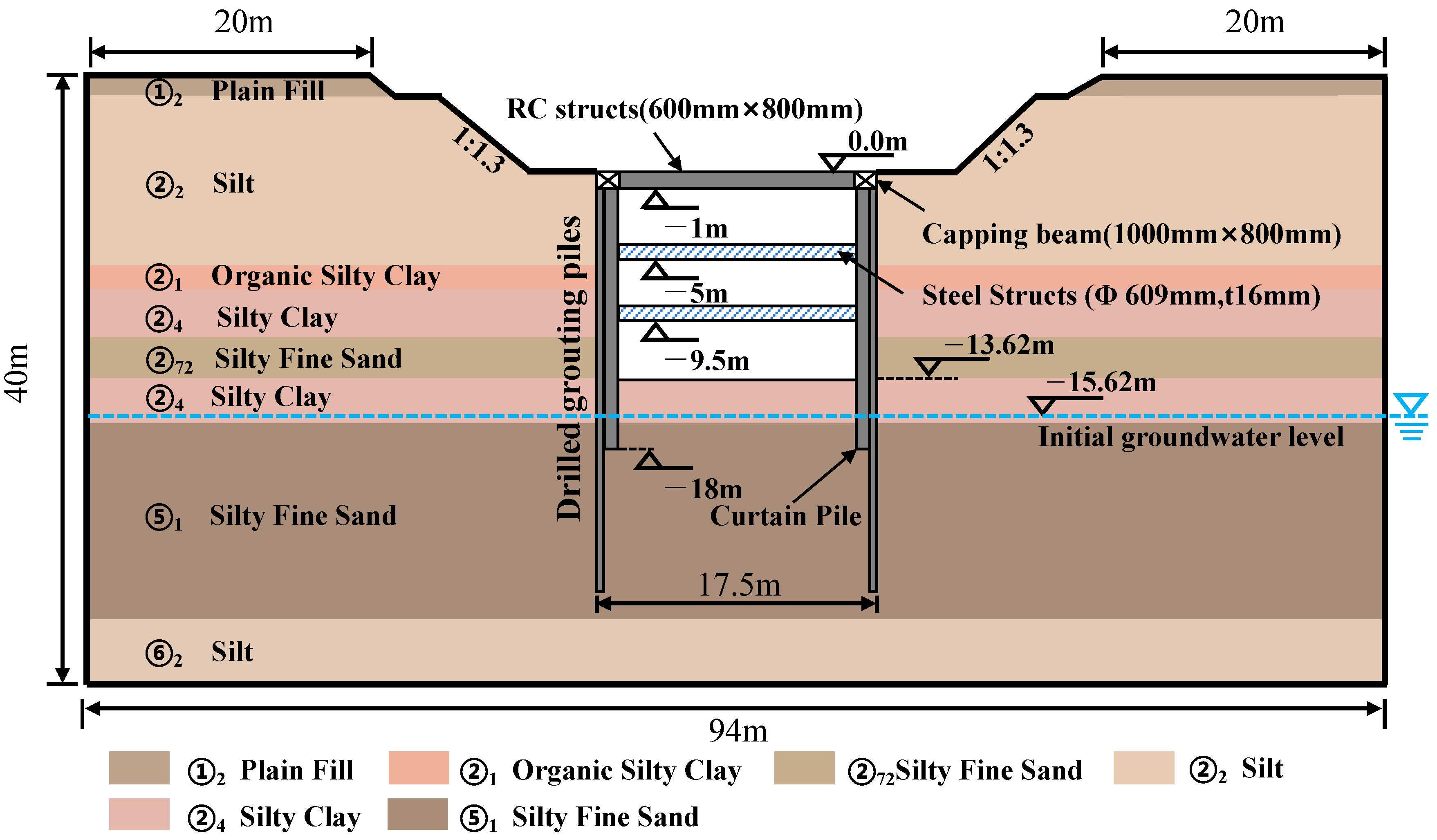

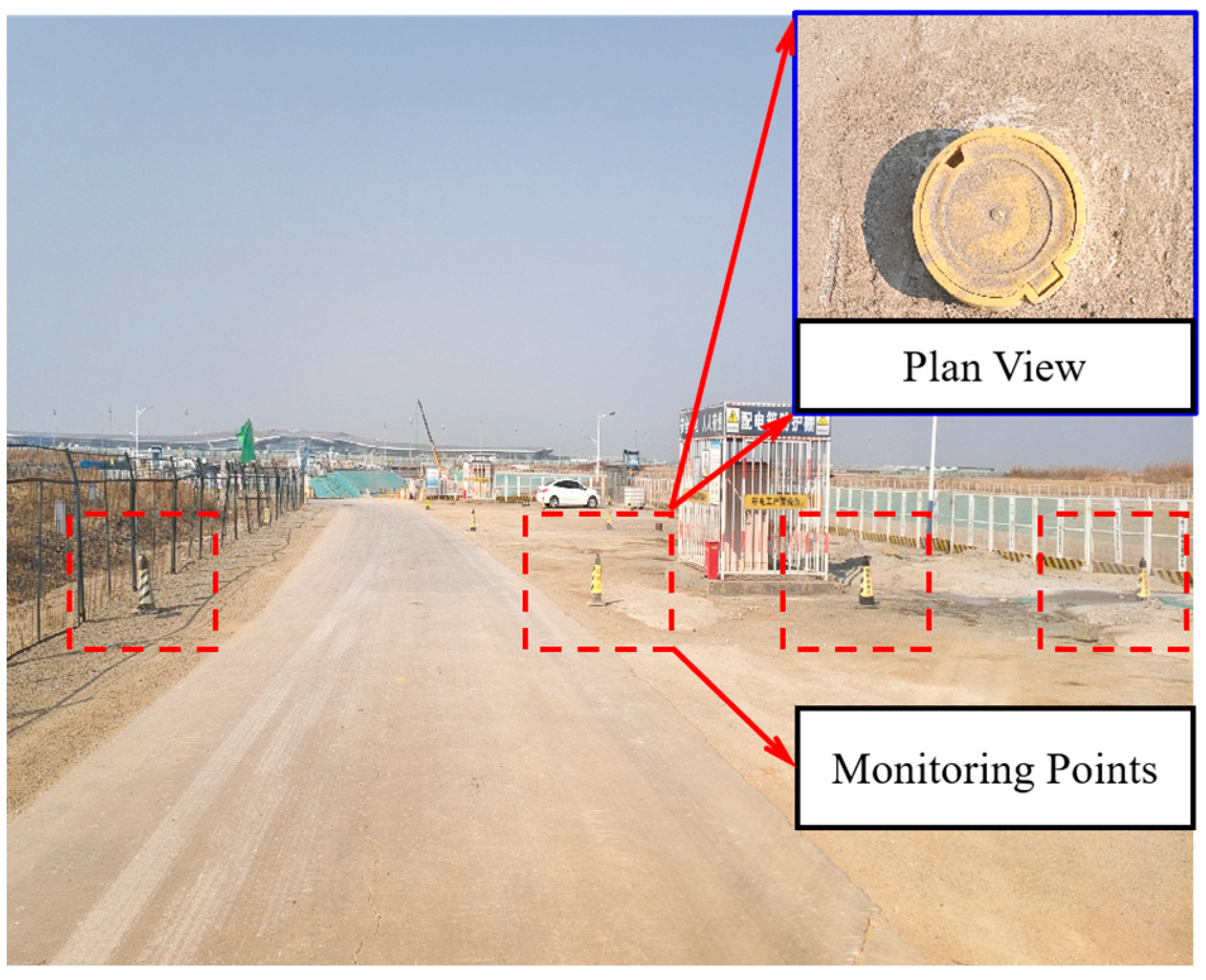

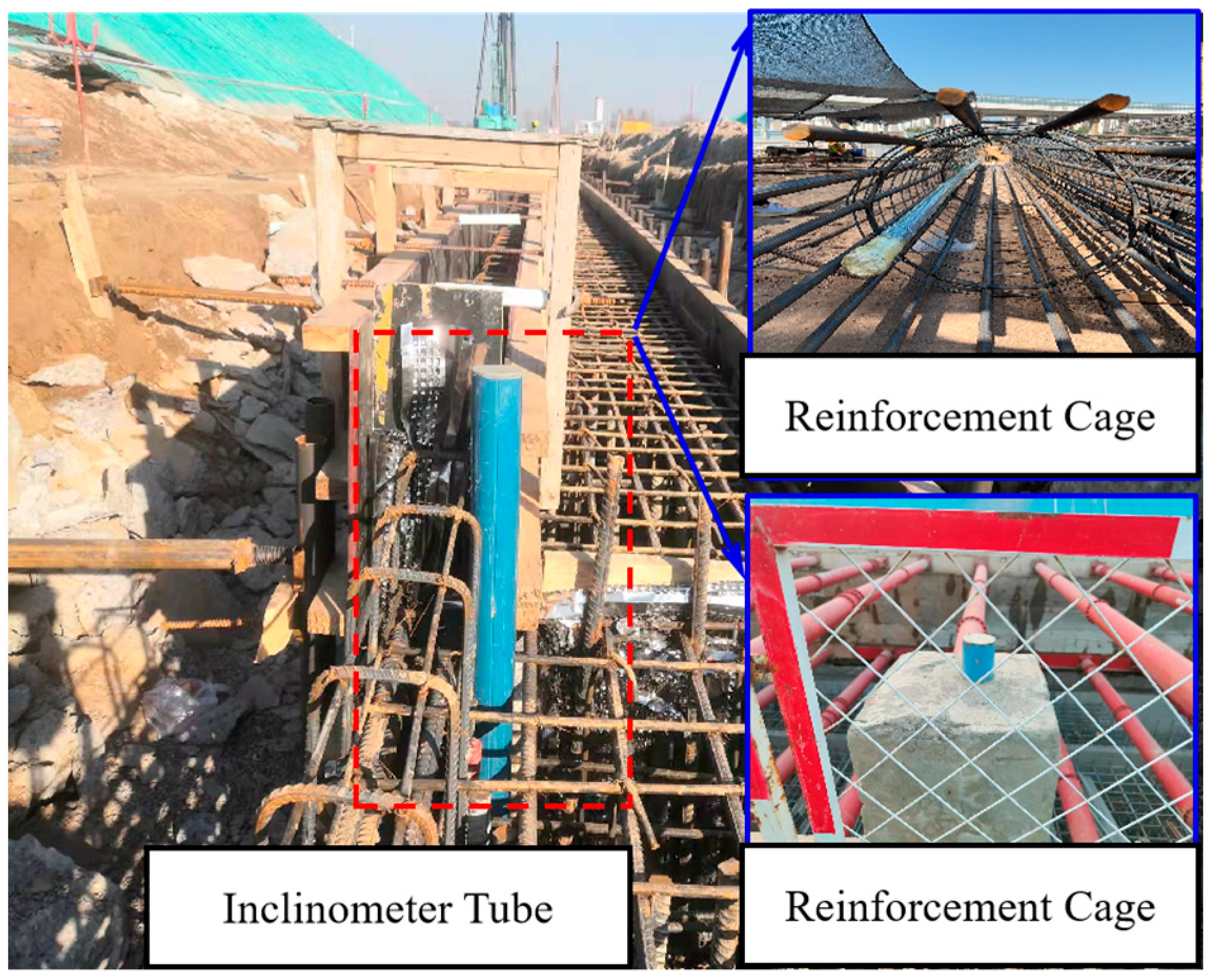
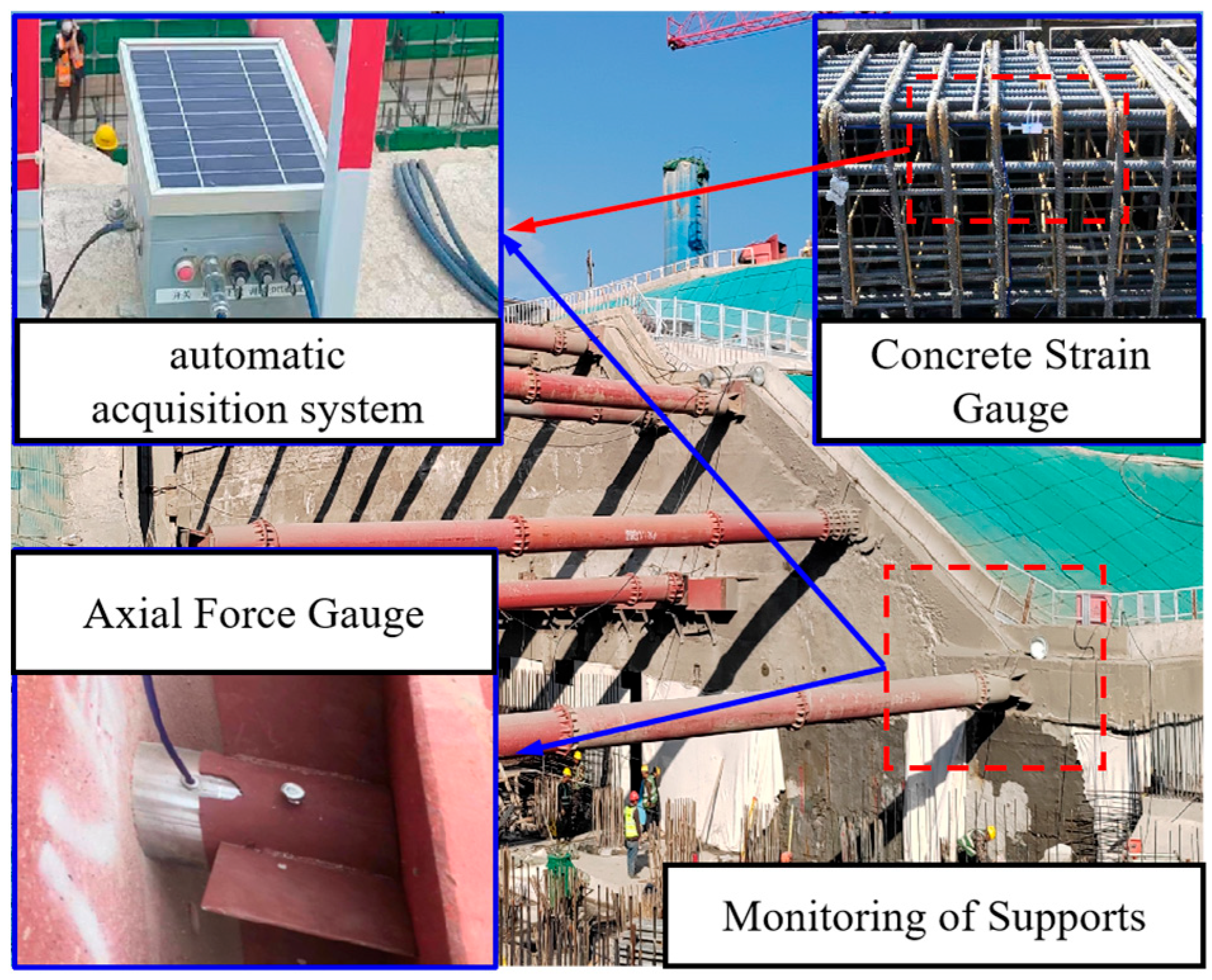

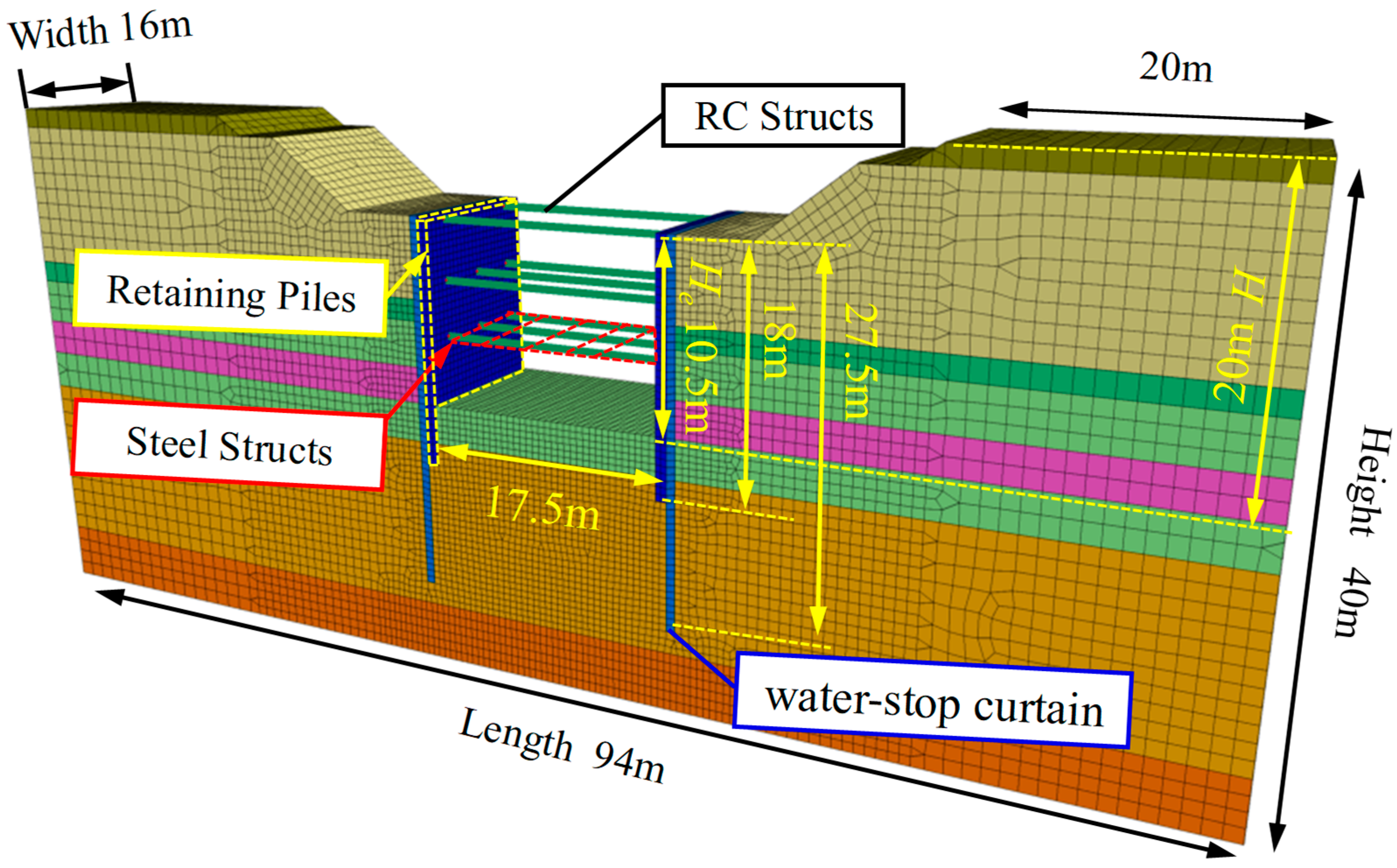
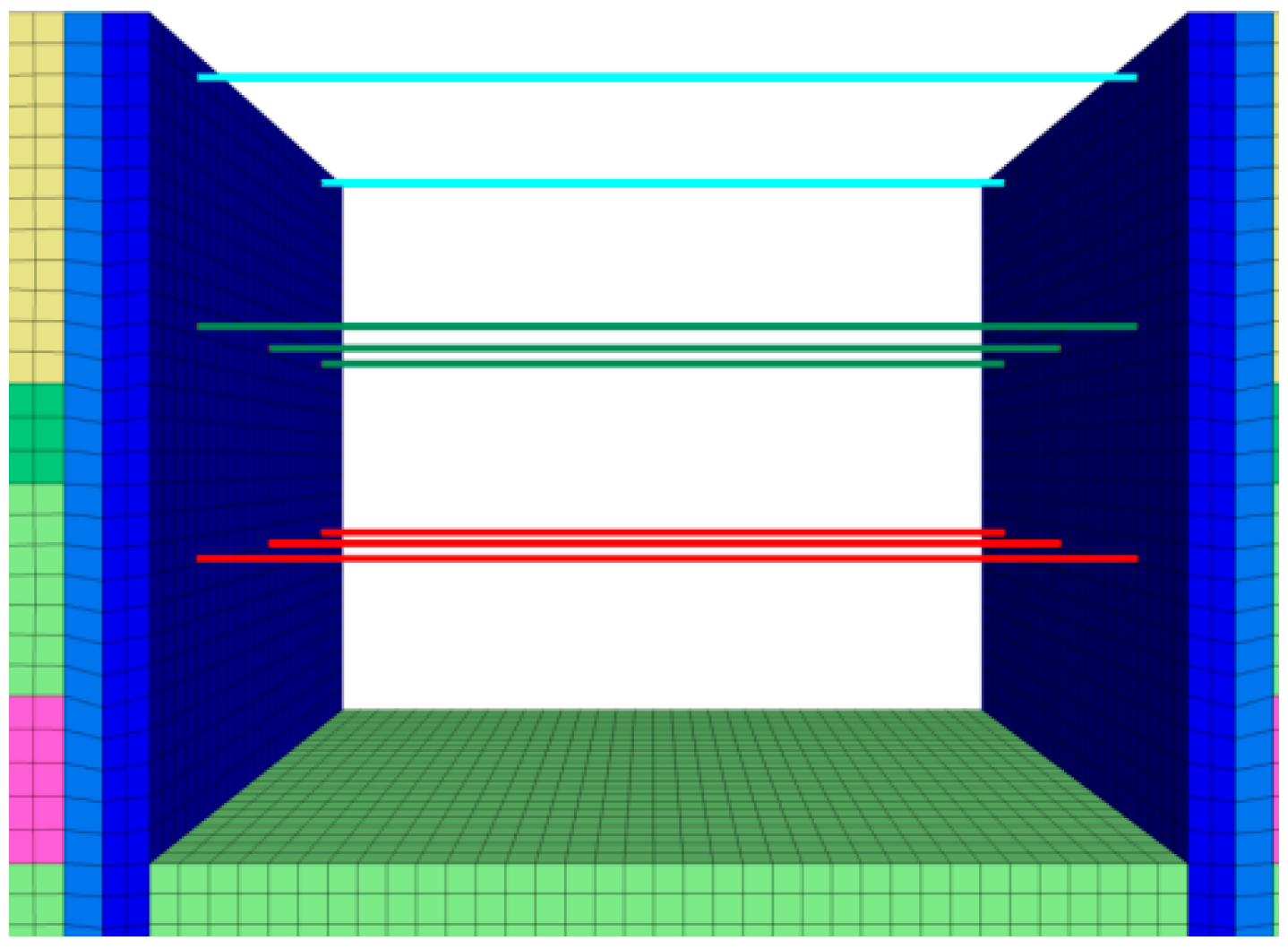

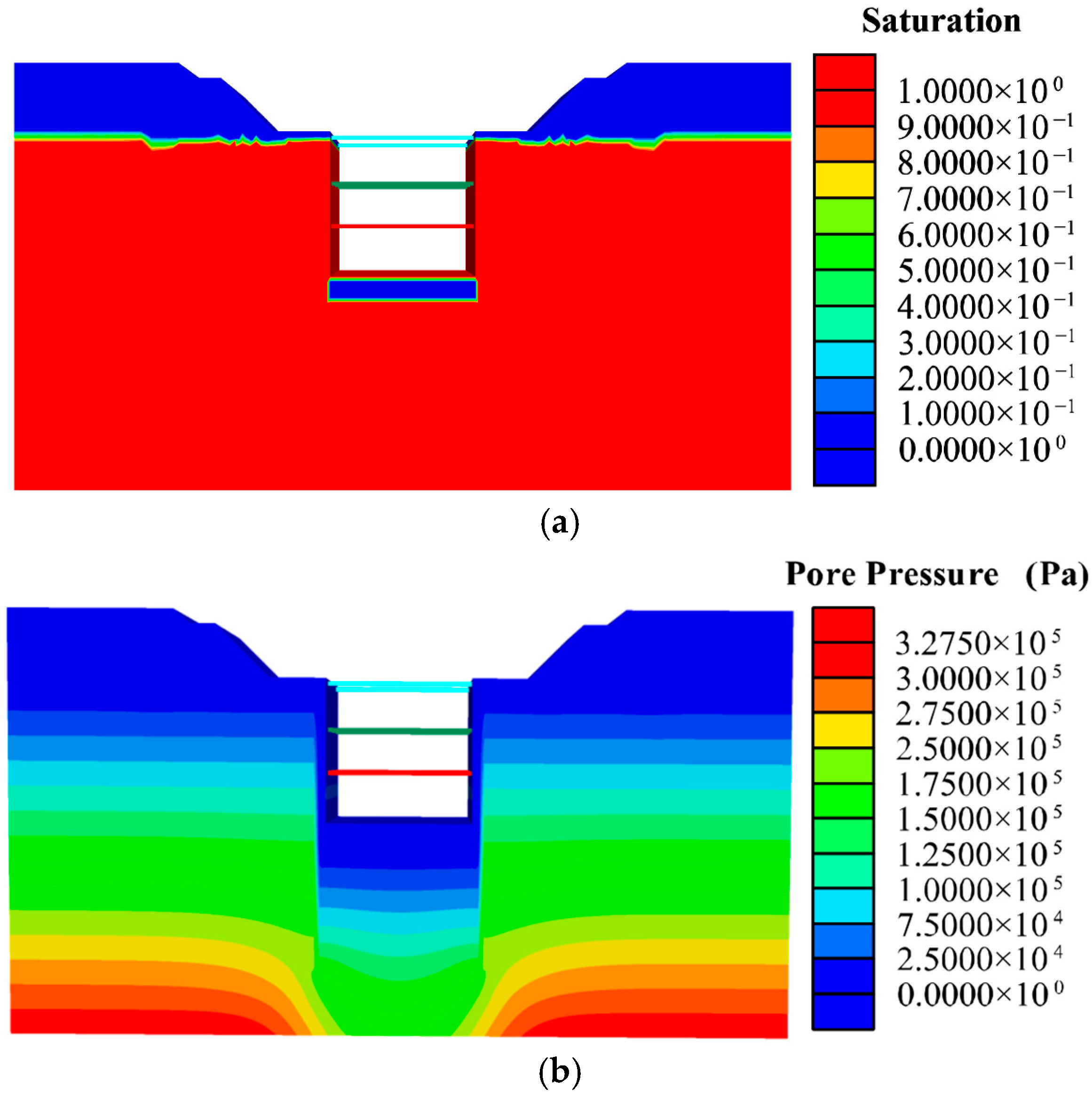

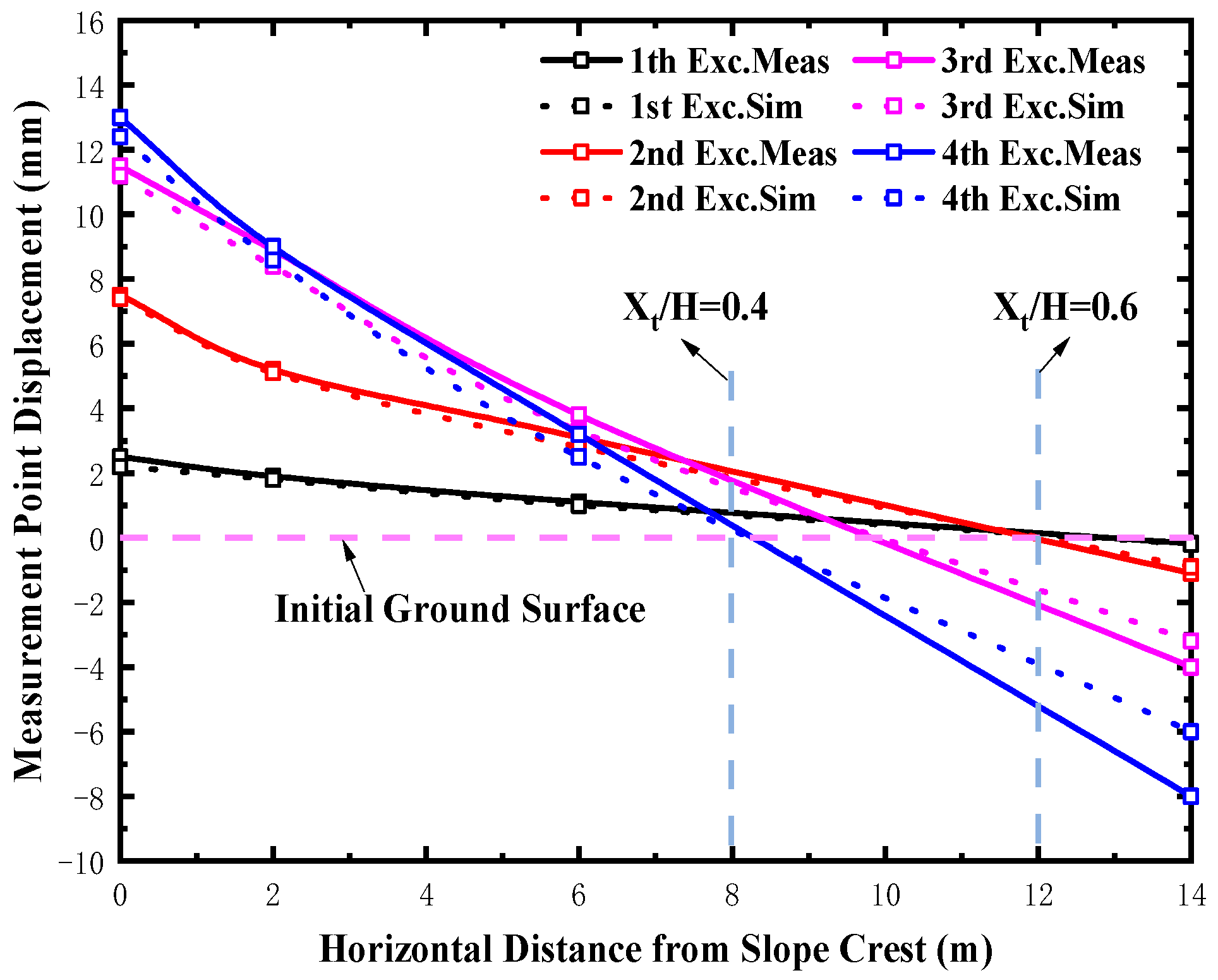
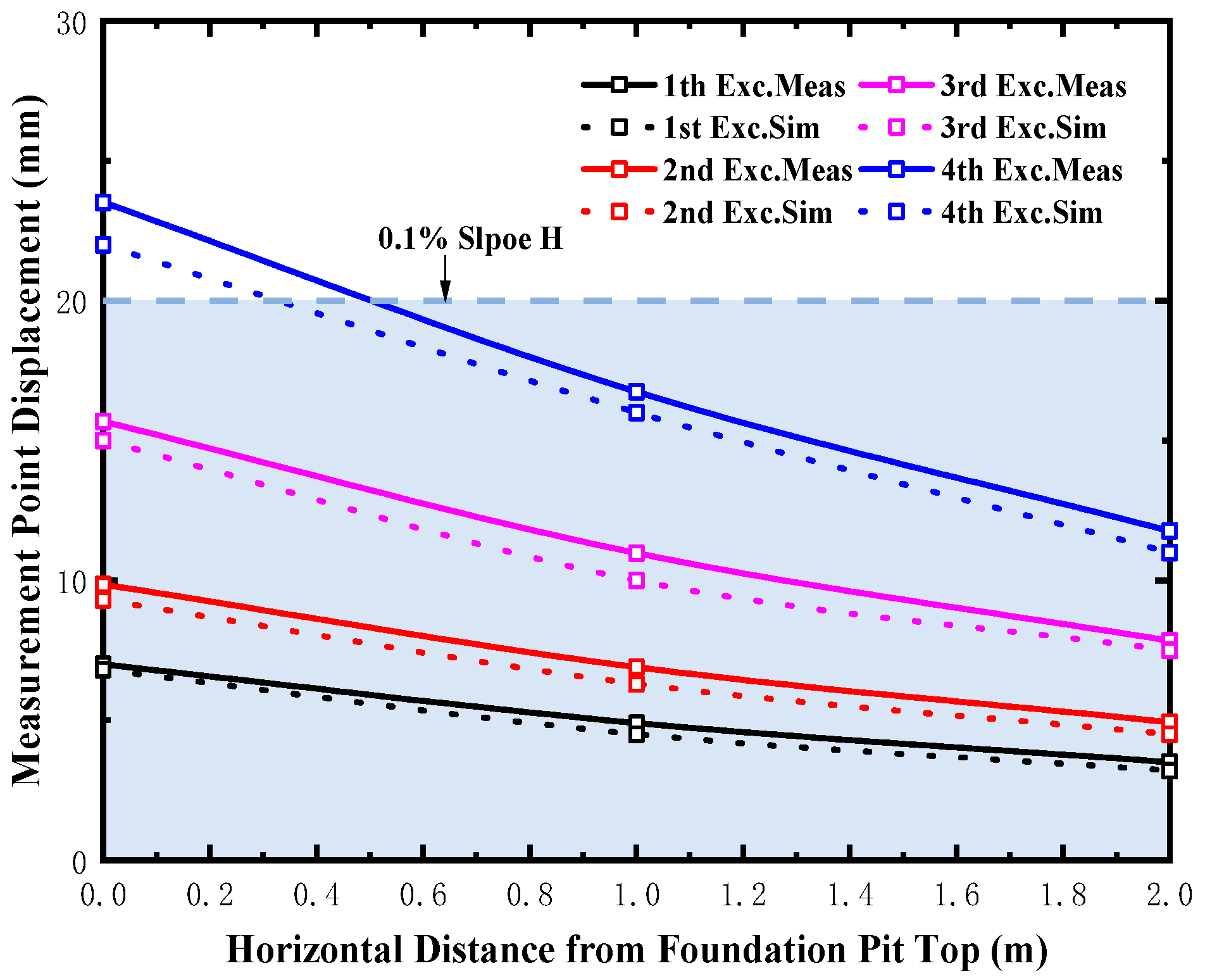
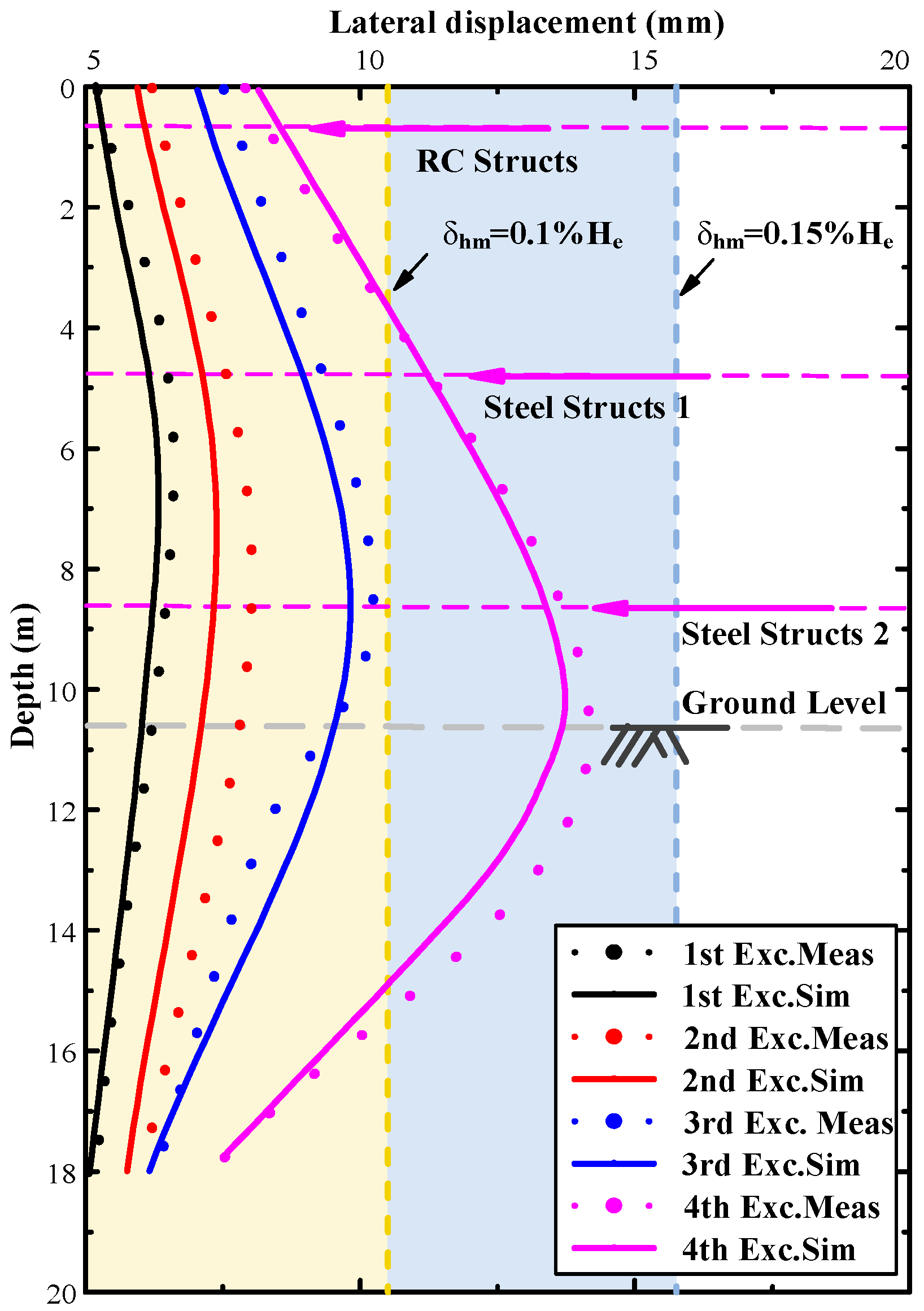
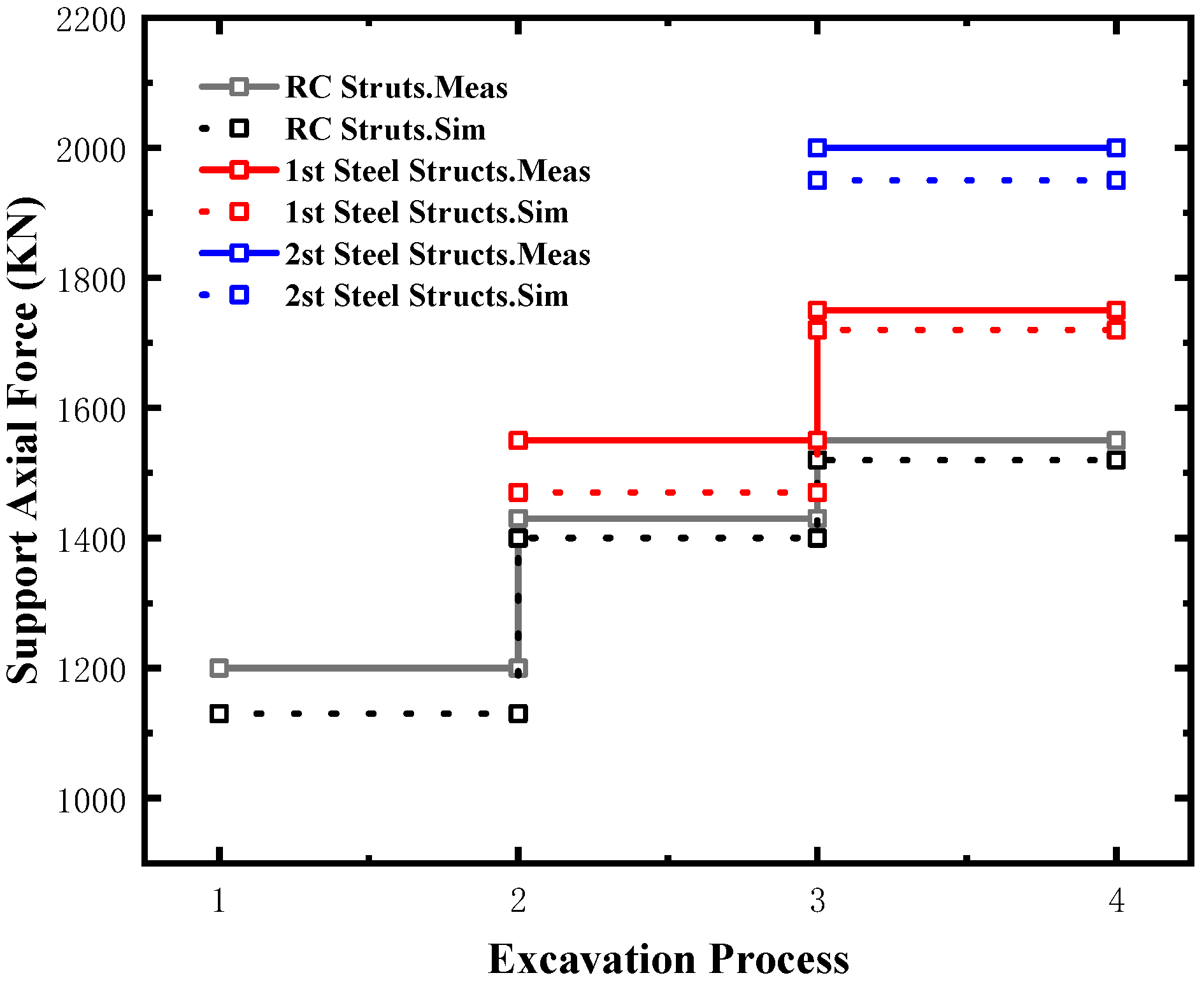
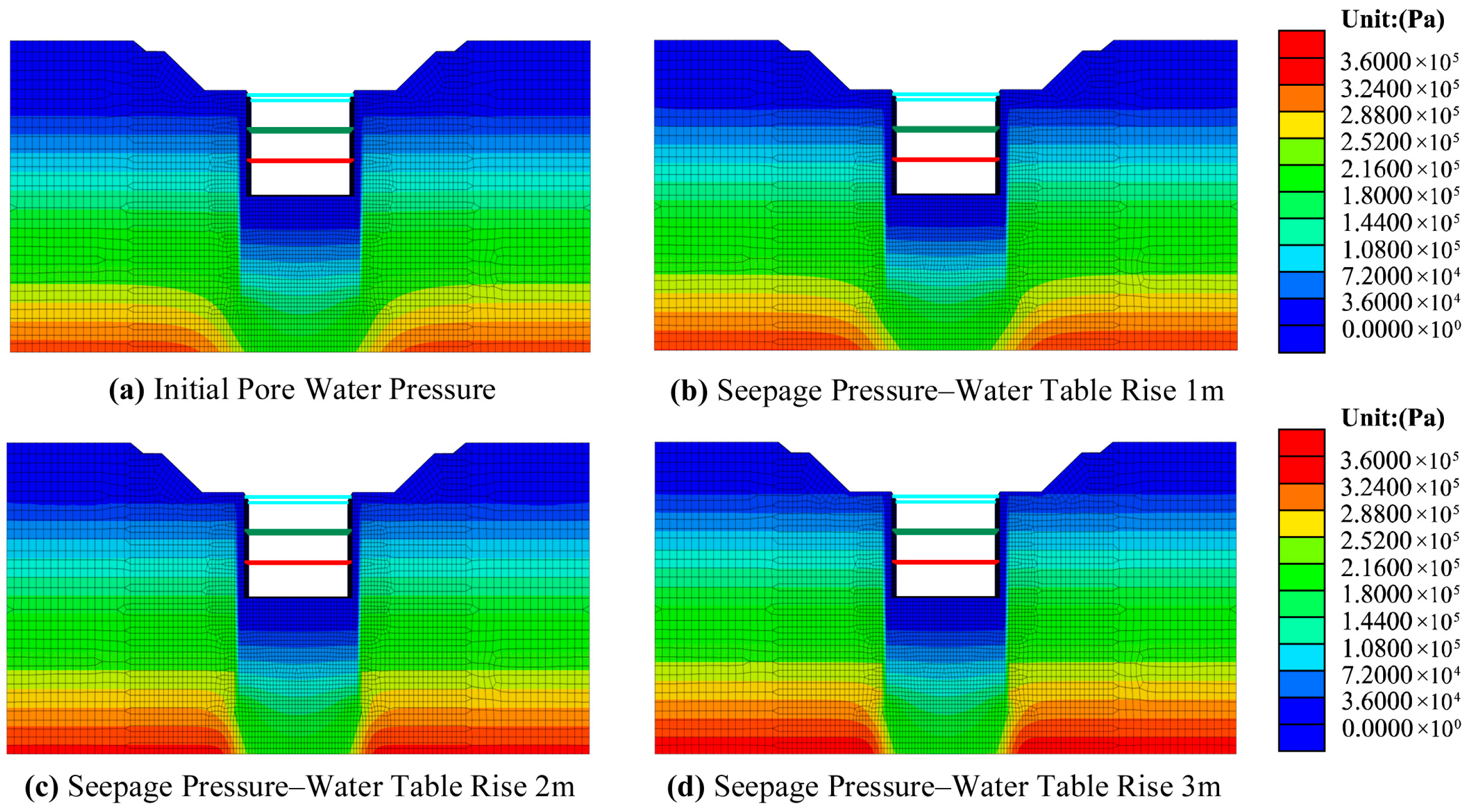
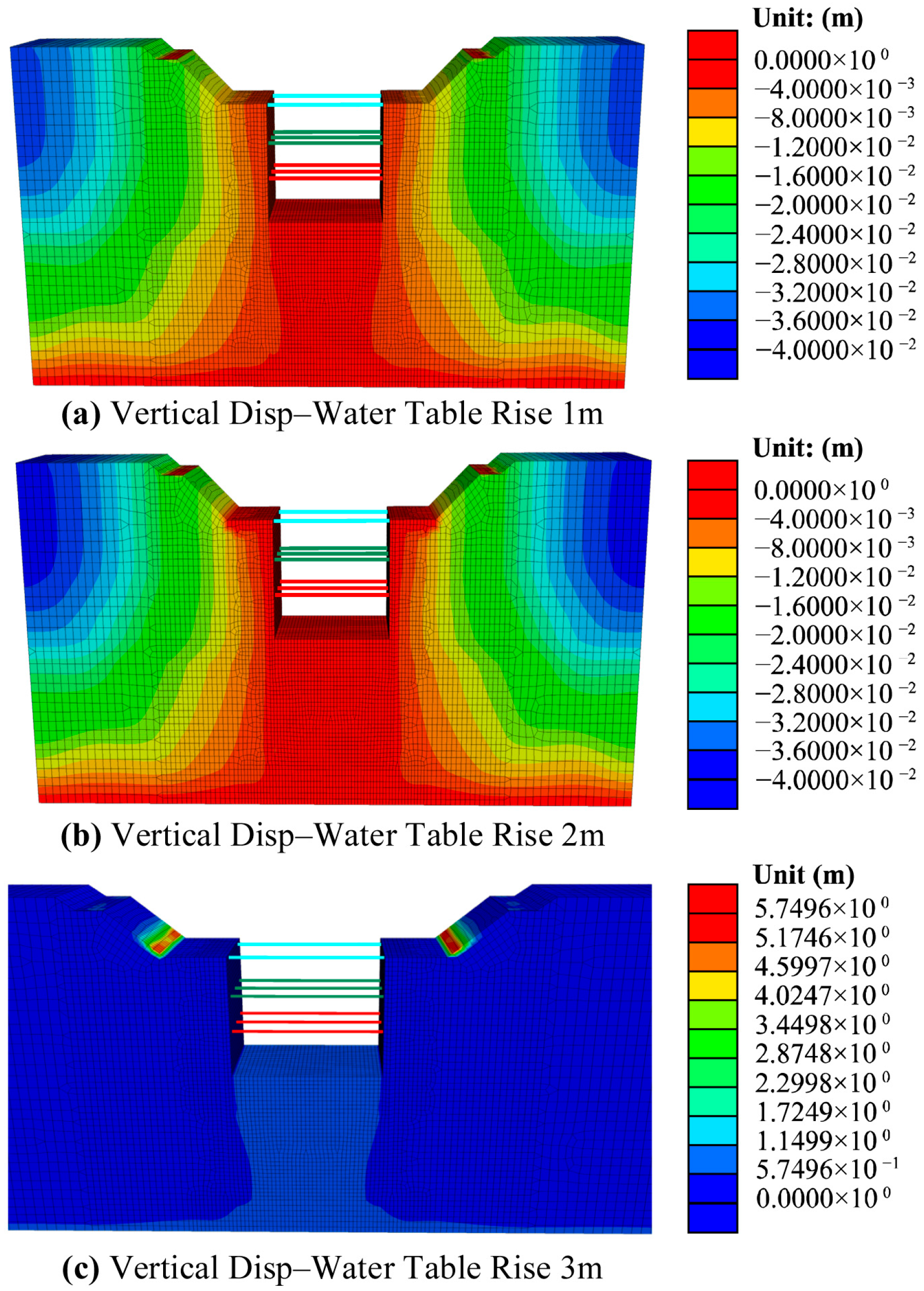


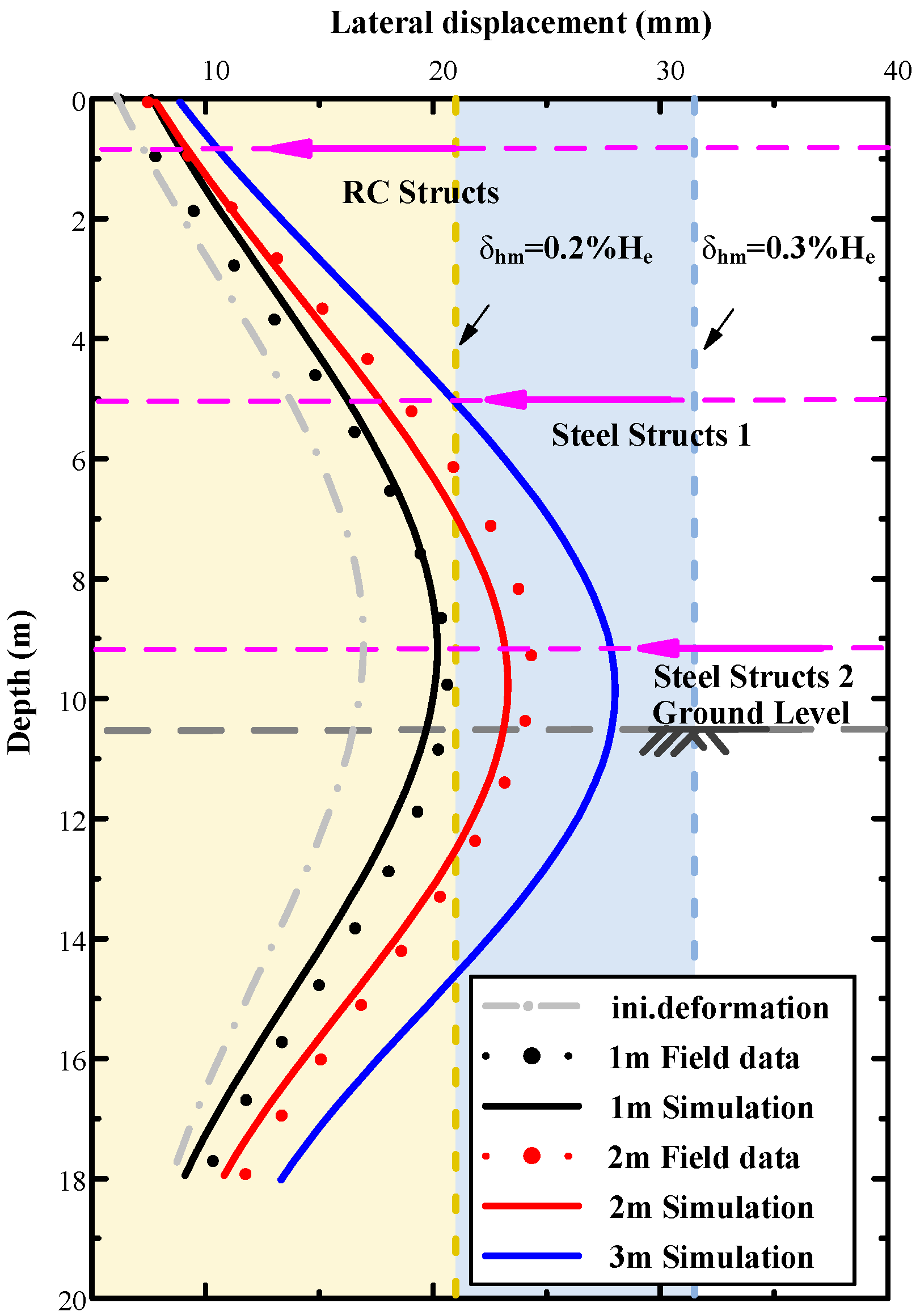

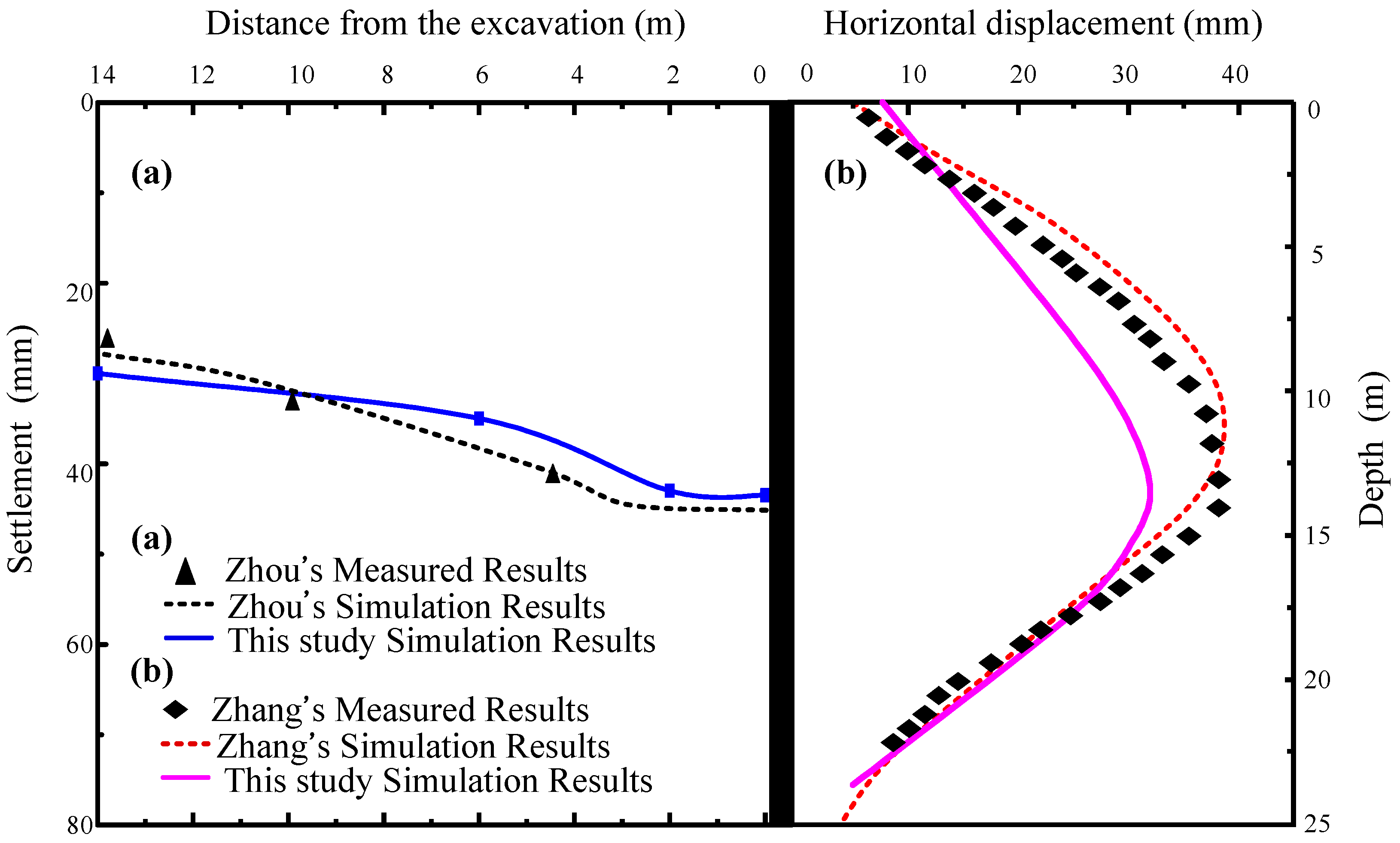
| Number | Soil Layer | Thickness H (m) | E (MPa) | γ (kN/m3) | c (kPa) | φ (°) |
|---|---|---|---|---|---|---|
| ①2 | Plain Fill | 1.42 | 8 | 17.5 | 21 | 13.5 |
| ②2 | Silt | 10.9 | 8.75 | 18.7 | 14 | 28 |
| ②1 | Organic Silty Clay | 1.6 | 4.33 | 18.6 | 34 | 14 |
| ②4 | Silty Clay | 3.4 | 5.7 | 19.8 | 31 | 18 |
| ②72 | Silty Fine Sand | 2.68 | 10.94 | 20.5 | 4 | 30 |
| ②4 | Silty Clay | 2.92 | 5.7 | 19.8 | 31 | 18 |
| ⑤1 | Silty Fine Sand | 12.74 | 16.2 | 20.5 | 4 | 30 |
| ⑥2 | Silt | 4.34 | 8.89 | 20.2 | 17 | 25 |
| ⑦ | Water-Stop Curtain Pile | 27.62 | 82.6 | 25.5 | ||
| ⑧ | Drilled Pile | 18 | 3 × 104 | 25.5 |
| Number | Monitoring Item | Instrument | Monitoring Accuracy |
|---|---|---|---|
| 1 | Horizontal displacement at Slope Crest | Total Station | ≤1.0 mm |
| 2 | Vertical displacement at Slope Crest | Electronic Level | ≤0.3 mm |
| 3 | Horizontal displacement of retaining pile | Inclinometer | ≤0.25 mm/m |
| 4 | Strut axial force | Automatic Frequency Reader | ≥0.5%F·S |
| 5 | Ground surface settlement | Electronic Level | ≤0.3 mm |
| 6 | Groundwater level | Integrated Water Level Gauge | ≤10 mm |
| Support | First Support | Second Support | Third Support |
|---|---|---|---|
| Material | C30 Concrete | Q235B Steel Support | Q235B Steel Support |
| Section | Φ600 × 800 | Φ609 × 16 | Φ609 × 16 |
| E (Pa) | 3 × 1010 | 21 × 1010 | 21 × 1010 |
| Poisson’s Ratio ν | 0.3 | 0.25 | 0.25 |
| Cross-sectional Area A (m2) | 0.48 | 2.98 × 10−2 | 2.98 × 10−2 |
| Density ρ (kg/m3) | 3000 | 7850 | 7850 |
| Moment of Inertia Iy (m4) | 2.56 × 10−2 | 1.31 × 10−3 | 1.31 × 10−3 |
| Moment of Inertia Iz (m4) | 2.56 × 10−2 | 1.31 × 10−3 | 1.31 × 10−3 |
| Working Conditions | Research Indicators | |
|---|---|---|
| Groundwater rise | 1 m | Horizontal displacement of the foundation pit |
| 2 m | Displacement of surrounding soil | |
| 3 m | Axial force of foundation pit supports | |
| Layered Excavation Support | Excacation① Excacation② Excacation③ Excacation④ | Horizontal displacement of the foundation pit |
| Displacement of surrounding soil | ||
| Axial force of foundation pit supports | ||
Disclaimer/Publisher’s Note: The statements, opinions and data contained in all publications are solely those of the individual author(s) and contributor(s) and not of MDPI and/or the editor(s). MDPI and/or the editor(s) disclaim responsibility for any injury to people or property resulting from any ideas, methods, instructions or products referred to in the content. |
© 2025 by the authors. Licensee MDPI, Basel, Switzerland. This article is an open access article distributed under the terms and conditions of the Creative Commons Attribution (CC BY) license (https://creativecommons.org/licenses/by/4.0/).
Share and Cite
Zhao, W.; Li, J.; Xi, S. Mechanical Response and Health Monitoring of Deep Excavations Under Extreme Rainfall. Buildings 2025, 15, 4167. https://doi.org/10.3390/buildings15224167
Zhao W, Li J, Xi S. Mechanical Response and Health Monitoring of Deep Excavations Under Extreme Rainfall. Buildings. 2025; 15(22):4167. https://doi.org/10.3390/buildings15224167
Chicago/Turabian StyleZhao, Wending, Junjun Li, and Shujuan Xi. 2025. "Mechanical Response and Health Monitoring of Deep Excavations Under Extreme Rainfall" Buildings 15, no. 22: 4167. https://doi.org/10.3390/buildings15224167
APA StyleZhao, W., Li, J., & Xi, S. (2025). Mechanical Response and Health Monitoring of Deep Excavations Under Extreme Rainfall. Buildings, 15(22), 4167. https://doi.org/10.3390/buildings15224167





